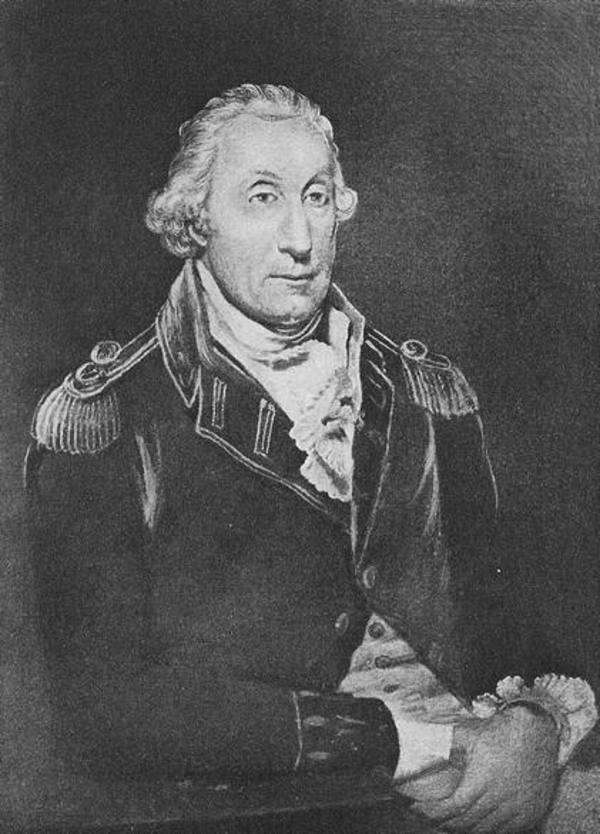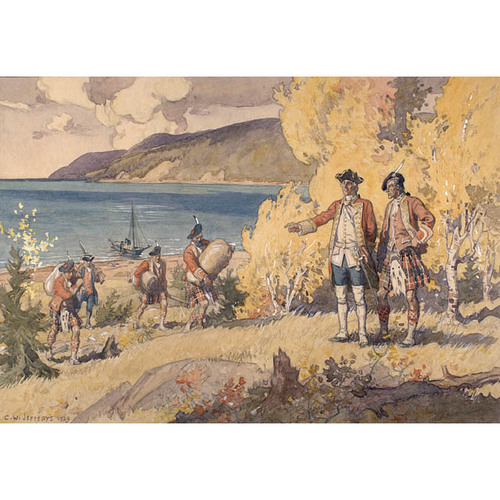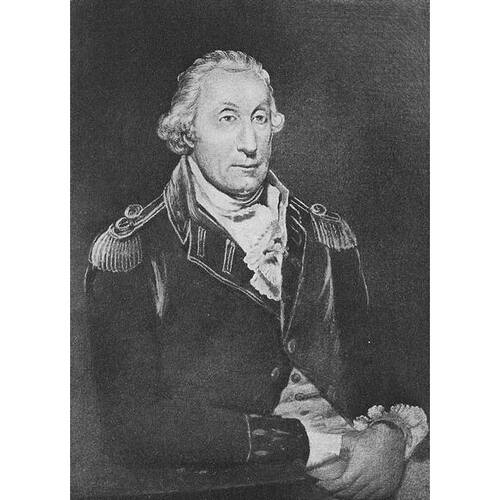
Source: Link
NAIRNE, JOHN, army and militia officer and seigneur; b. 1 March 1731 in Scotland; d. 14 July 1802 at Quebec, Lower Canada.
John Nairne came from a Scottish family with Jacobite sympathies. After studying in Edinburgh he enlisted at the age of 14 with the Scots Brigade in the Dutch service, joining the first battalion of Stewart’s Regiment. In 1757 Nairne returned to Scotland and obtained a lieutenant’s commission in the 78th Foot. He arrived with his regiment on Île Royale (Cape Breton Island) in June of that year and took part in the capture of Louisbourg in 1758 and of Quebec in 1759. Like all the men in the regiment Nairne suffered rather badly from the rigours of his first winter at Quebec and gratefully accepted the warm woollen stockings that the nuns knitted for the men in kilts. The severity of the winter did not seem to demoralize Captain Nairne, who had borrowed £400 from James Murray* to buy his new commission.
In September 1761 Nairne went to La Malbaie with his friend and companion in arms, Malcolm Fraser. Satisfied with what he saw, he asked Murray for a grant of land. In his desire to secure as much acreage as possible he stressed the large number of mountains and marshes in the region that he had visited. His inclination to settle in the province probably stemmed from the poor state of his finances, which left him little hope of making a career in Scotland. In addition he thought that in the new British colony he could lead the pleasant life of the French seigneurs. On 27 April 1762 Murray divided the seigneury of La Malbaie in two and granted it to Nairne and Fraser. Fraser took Mount Murray and Nairne took Murray Bay, which included the village of La Malbaie. To buy the equipment and existing buildings Nairne had to pay out £85 6s. 8d.
Upon taking possession of his land Nairne retired from the army on half pay. He brought some soldiers of the 78th Foot with him, because he wanted above all to found a small Scottish and Protestant settlement on his lands. But the Warrens, Harveys, MacLeans, and Blackburns who came with him married Canadians, and within a generation the new settlers had created families that were Scottish in name but Canadian in religion, language, and customs – a painful miscarriage of plans for the seigneur.
Nairne applied himself to farming and to developing his domain and the seigneury, which he had surveyed in 1764. The following year he asked for a road to be built between Quebec and La Malbaie; this request and several subsequent ones went unanswered for a long time. Nairne also worked at implanting Protestantism; he corresponded with the Protestant minister at Quebec, John Brooke*, and with ministers in England, asking them to send him clergymen. Once again he suffered a setback, for there were then only five Protestant families at Murray Bay. Nairne, who proved a good farmer, constantly lamented that the Roman Catholic faith and its round of feast days prevented his censitaires from maintaining sufficient production. He was not rich, the seigneury brought in little revenue, and this determined Scot wanted to change his circumstances.
In 1766 Nairne entered into a relationship with Christiana Emery, a Scot whom he married on 20 July 1769 at Quebec. It would never have entered his head to share his life with someone not a compatriot. He had chosen Christiana because she was distinguished and had the qualities of austerity and industry that he was looking for. Immediately after they united their lives, the couple left on a long trip to Scotland. In 1773 Nairne went back to Scotland alone; by then he was the father of four children, of whom all but one died at Murray Bay during his absence. He and Christiana were subsequently to have five more children. Apart from trips to Scotland Nairne attended to his seigneury until 1775: he made land grants, built a sumptuous manor-house, undertook to market the products of the seigneury, and, being fond of hunting and fishing, at last led the seigneur’s life he had dreamed of.
On 13 July 1775, in the face of an imminent American invasion of Canada [see Benedict Arnold; Richard Montgomery*], Governor Guy Carleton gave Nairne the task of organizing a regiment of Canadians from La Malbaie, Les Éboulements, and Baie-Saint-Paul. On 12 August Nairne wrote to Carleton, offering to serve in any vacant captaincy. On 9 September he was summoned to Quebec and given the rank of captain in a battalion of the Royal Highland Emigrants, a regiment of Scots from the former 78th Foot. Under Henry Caldwell’s orders Nairne played a leading role in the stubborn resistance put up by soldiers and militiamen during the siege of Quebec; he killed an American soldier who was threatening Captain George Lawe, then captured the group detaining him. Nairne said he deeply regretted this campaign and the fact that he had to fight men who spoke his own language and had been brought up as he had. He fought dispassionately and considered the war a painful necessity. None the less, in loyalty to the land of his birth, he continued his military career for eight years, being promoted major in the army on 29 Aug. 1777. He served at Montreal in 1776, Île aux Noix in 1777, and Carleton Island (N.Y.) in 1779; at the last-named location he supervised the rebuilding of the fort and kept watch over the prisoners. Back in Montreal that year, on Haldimand’s orders he arrested Valentin Jautard* and Fleury Mesplet*. Later he returned to Murray Bay, where he oversaw the building of the jail. In 1781 he was on duty at Verchères, where he was in charge of loyalists. He was made lieutenant-colonel in the army on 19 Feb. 1783; having received this commission, he waited a while, then in the autumn sold for £3,000 his commission as major in the Royal Highland Emigrants, which he had obtained three years earlier. He lost no time returning to Murray Bay to pursue the country life which made him happy.
Nairne settled permanently at Murray Bay but maintained his friendly links with Quebec, where he subscribed to the Agriculture Society, as well as to an association founded in 1794 to support the British government, and to the Fire Society. He was also in the Quebec Battalion of British Militia in 1794 as lieutenant-colonel. Everything was going well at Murray Bay. In 1798 the parish that had been created on Nairne’s seigneury had more than 500 habitants, including 100 men able to bear arms; there were also mills, fishing rooms, good houses and barns, fertile fields, and a priest with whom Nairne was on excellent terms despite his reservations. Nairne owned three farms, each with 100 acres of arable land, and numerous buildings. The seigneury produced and exported wood, furs, and products from the white whale. The manor-house had become a warm and comfortable dwelling, well finished and handsomely appointed.
Nairne was possessed of indomitable pride and will-power. This man, whose refined face was full of goodness and kindness, displayed great strength of character, but he was sad, always sad. His repeated lack of success in imparting a Scottish and Protestant spirit to the settlement at Murray Bay was intensified by the fact that his children quickly disappointed him. When young they spoke only French, and Nairne had to send each of them to Scotland for several years. He himself saw to the education of those remaining at the manor-house. His efforts were to no avail. His daughter Magdalen married a Catholic, Peter McNicol; Mary secretly married a habitant, Augustin Blackburn, and never returned to the manor-house; and Christine, who remained single, turned out to be a socialite and much preferred life at Quebec to the more monotonous one at home. Nairne made a great effort to welcome visitors and in this way attract his daughter back to Murray Bay; guests spent the summer there, passing their time in hunting and fishing. Nairne’s greatest sorrow, however, was occasioned by the death of his son John in India in 1799.
In 1802, when he was ill, Nairne asked to be taken to Quebec. There, on Rue des Grisons, he died on 14 July. Thomas, the only son to survive him, was unsuited for the life of a country gentlemen, and chose the army. He died on service at Carleton Island in 1813. Nairne’s wife took care of the seigneury until her death in 1828.
ANQ-Q, CN1-83, 11, 12 juin 1787; CN1-99, 9 juill. 1805; CN1-245, 3 août 1784, 6 juill. 1785; CN1-284, 5 oct. 1789. PAC, MG 23, GIII, 23. “By the honble James Murray, Esq, governor of Quebec etc., etc.,” BRH, 40 (1934): 116. P. Campbell, Travels in North America (Langton and Ganong). Quebec Gazette, 26 July 1787; 22 April 1790; 5, 19 May 1791; 11 April 1793; 23 Oct. 1794; 17 Oct. 1799; 15 July 1802. Caron, “Inv. de la corr. de Mgr Hubert et de Mgr Bailly de Messein,” ANQ Rapport, 1930–31: 245. Kelley, “Church and State papers,” ANQ Rapport, 1948–49: 321. Papers illustrating the history of the Scots Brigade in the service of Holland, ed. James Ferguson (3v., Edinburgh, 1899–1901), 2: 410. “Papiers d’État,” PAC Rapport, 1890: 119. P.-G. Roy, Inv. concessions, 5: 102–3. George Gale, Quebec twixt old and new (Quebec, 1915), 229. Roger Le Moine, La Malbaie, esquisse historique (La Malbaie, Qué., 1972). G. M. Wrong, A Canadian manor and its seigneurs, the story of a hundred years, 1761–1861 (Toronto, 1908). Marius Barbeau, “Pile ou face pour une seigneurie,” Le Canada français (Québec), 2e sér., 27 (1939–40): 294–308. Ivanhoë Caron, “Le Chemin des caps,” BRH, 32 (1926): 23–41. R. W. McLachlan, “Fleury Mesplet, the first printer at Montreal,” RSC Trans., 2nd ser., 12 (1906), sect.ii: 197–309. P.-G. Roy, “Les concessions en fief et seigneurie sous le Régime anglais,” BRH, 34 (1928): 321–25; “Saint-Étienne de la Malbaie,” BRH, 1 (1895): 123–24. W. S. Wallace, “Some notes on Fraser’s Highlanders,” CHR, 18 (1937): 131–40.
Cite This Article
Jacqueline Roy, “NAIRNE, JOHN,” in Dictionary of Canadian Biography, vol. 5, University of Toronto/Université Laval, 2003–, accessed April 4, 2025, https://www.biographi.ca/en/bio/nairne_john_5E.html.
The citation above shows the format for footnotes and endnotes according to the Chicago manual of style (16th edition). Information to be used in other citation formats:
| Permalink: | https://www.biographi.ca/en/bio/nairne_john_5E.html |
| Author of Article: | Jacqueline Roy |
| Title of Article: | NAIRNE, JOHN |
| Publication Name: | Dictionary of Canadian Biography, vol. 5 |
| Publisher: | University of Toronto/Université Laval |
| Year of revision: | 1983 |
| Access Date: | April 4, 2025 |




